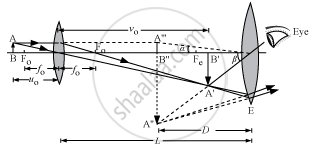Advertisements
Advertisements
प्रश्न
A compound microscope has an objective of focal length 1.25 cm and eyepiece of focal length 5 cm. A small object is kept at 2.5 cm from the objective. If the final image formed is at infinity, find the distance between the objective and the eyepiece ?
उत्तर

Distance between the objective and the eyepiece, L =
\[u_0 = - 2 . 5 \text {cm and } f_0 = 1 . 25 cm\]
\[\text { Now }, - \frac{1}{u_0} + \frac{1}{v_0} = \frac{1}{f_0}\] \[or \ v_0 = 2 . 5 cm\]
To find ue, we have:
\[v_e = \infty\text { and } f_e = 5 cm\]
Calculating using the same formula as above, we get:
संबंधित प्रश्न
Explain the basic differences between the construction and working of a telescope and a microscope
Define the magnifying power of a compound microscope when the final image is formed at infinity. Why must both the objective and the eyepiece of a compound microscope has short focal lengths? Explain.
When are two objects just resolved? Explain.
How can the resolving power of a compound microscope be increased? Use relevant formula to support your answer.
Draw a ray diagram showing image formation in a compound microscope ?
An object is to be seen through a simple microscope of focal length 12 cm. Where should the object be placed so as to produce maximum angular magnification? The least distance for clear vision is 25 cm.
A simple microscope is rated 5 X for a normal relaxed eye. What will be its magnifying power for a relaxed farsighted eye whose near point is 40 cm?
The separation between the objective and the eyepiece of a compound microscope can be adjusted between 9.8 cm to 11.8 cm. If the focal lengths of the objective and the eyepiece are 1.0 cm and 6 cm respectively, find the range of the magnifying power if the image is always needed at 24 cm from the eye
A compound microscope consists of an objective of focal length 1 cm and an eyepiece of focal length 5 cm. An object is placed at a distance of 0.5 cm from the objective. What should be the separation between the lenses so that the microscope projects an inverted real image of the object on a screen 30 cm behind the eyepiece?
| A compound microscope consists of two converging lenses. One of them, of smaller aperture and smaller focal length, is called objective and the other of slightly larger aperture and slightly larger focal length is called eye-piece. Both lenses are fitted in a tube with an arrangement to vary the distance between them. A tiny object is placed in front of the objective at a distance slightly greater than its focal length. The objective produces the image of the object which acts as an object for the eye-piece. The eye-piece, in turn, produces the final magnified image. |
The magnification due to a compound microscope does not depend upon ______.
